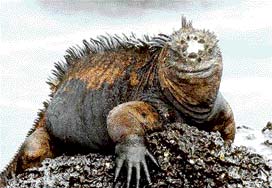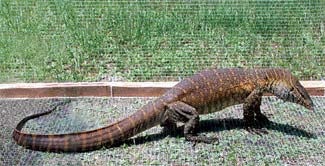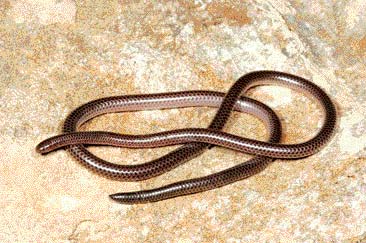|

The only marine lizard species
 Several species of lizard live along the shoreline, but only one
species relies on the sea for its survival. It is the marine iguana
which lives on the Galapagos Islands. Several species of lizard live along the shoreline, but only one
species relies on the sea for its survival. It is the marine iguana
which lives on the Galapagos Islands.
The Galapagos Islands are a remote group of volcanic rocks in the
Pacific Ocean.
The unusual lizards - the marine iguanas are usually black in colour,
but some males develop striking red and green blotches during the summer
breeding season.
These colour blotches are formed from certain seaweeds that grow
during that season. The iguanas' skin colour generally helps them to
absorb the sun's heat and also keep warm after a chilly swim in the sea.
The marine iguanas live in large groups or colonies, on the rocks
along the shoreline. Would you believe that as they eat seaweed which
grows under water, they need to dive down to graze the seabed? Their
wide, horney lips help them to scrape the slippery seaweed from the
rocks. These lizards are the rulers of the water.During the breeding
season, the males attempt to set up harems (group of females). So, if
there is competition from other males, the iguanas fight by headbutting.
These fights last for hours or even days!
Why water monitors lay eggs in termite mounds
 One of the largest species of lizards in the world is the water or
Nile monitor. These monitors live in Africa. The adult monitors
generally have few enemies, but they need to protect their eggs from
being eaten by other animals. So, they realise that the best place to
lay their eggs is in a termite mound. This way they can enlist the help
of the termites too to keep hunters at bay. One of the largest species of lizards in the world is the water or
Nile monitor. These monitors live in Africa. The adult monitors
generally have few enemies, but they need to protect their eggs from
being eaten by other animals. So, they realise that the best place to
lay their eggs is in a termite mound. This way they can enlist the help
of the termites too to keep hunters at bay.
The large female digs a nest in the termite mound without bothering
about the odd sting she encounters while doing so, from the termites.
She then lays her eggs in this nest. When the young monitors hatch out,
they also have a yummy first meal at hand - the termites!
How many lungs a snake has

The internal organs of a snake is tightly packed into the snake's
long, tube-shaped body. It has a heart, a liver, kidneys, stomach and
intestines and many other organs. Like the snake, these organs too are
generally long and thin. So, they usually fit into its body shape, but
still, the space inside is very tight, and it becomes so especially when
the snake has had a heavy meal.
Due to this limited space problem, most snakes have made a little
more room inside by having only one lung. In some, the left lung is not
there at all, or is just a tiny organ almost a useless bag. The right
lung extends over more than half the body length.
Why thread snakes live in owls' nests
Have you heard of a species of snakes known as thread snakes?
Perhaps, not. They are very small and thin snakes that spend most of
their time burrowing in soil,
 hunting for insects. They are often
mistaken for worms. Just as much as we humans are fooled by these thin
snakes, even screech owls are fooled by them. The owls carry these
worm-like thread snakes to feed the young into their nests. hunting for insects. They are often
mistaken for worms. Just as much as we humans are fooled by these thin
snakes, even screech owls are fooled by them. The owls carry these
worm-like thread snakes to feed the young into their nests.
Some of these thread snakes manage to escape from the owls once they
are in the owls' nest. They live in these nests, eating the insects in
the nests. In fact, nearly one in every five owl's nests in Texas is
said to be 'home' to these thread snakes.
Even though initially the snakes were taken into the nests as food
for the owl's babies, the snakes which end up living in these nests,
become a source of protection for the baby owls. Since the snakes eat
the insects which otherwise would have attacked the baby owls, the
little owls usually grow faster than most others in nests where thread
snakes are not living.
The Antilleaon thread snake which is found in Barbados and a few
islands nearby is the world's smallest snake. It never grows to more
than about five centimetres. It is narrow enough to slither through a
hole the size of a pencil head. |

